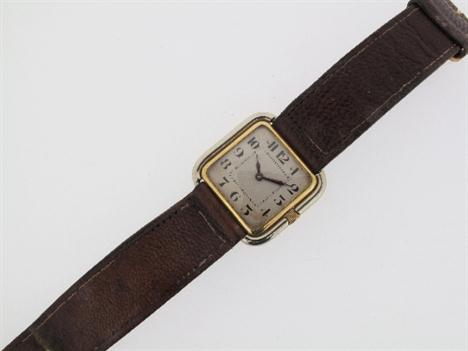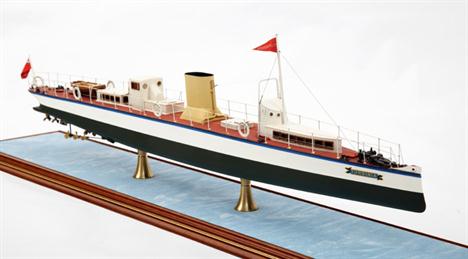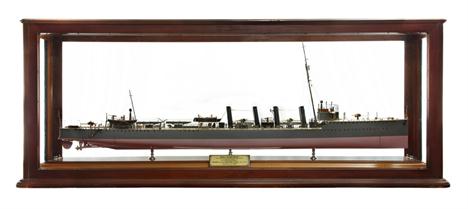We found 297893 price guide item(s) matching your search
There are 297893 lots that match your search criteria. Subscribe now to get instant access to the full price guide service.
Click here to subscribe- List
- Grid
-
297893 item(s)/page
A two colour gold wristwatch, white gold outer cylindrical bezel containing the yellow gold bezel with unsigned dial with Arabic numerals. Movement signed Vacheron & Constantine and numbered 389477. The case 2.7cm wide, marked 8022 with French control marks. The gold buckle numbered 67628 with French control mark and makers mark V&R within a lozenge. Leather band.
A pearl and diamond set ring, the pearl is millegrain set with six small shoulder diamonds, in platinum. Signed Coch. Size R. Accompanied with certificate number 06198 from The Gem and Pearl Laboratory dated 4th September 2012 stating that the button shaped pearl measures 7.1 - 7.2mm wide by 6 - 7mm deep, the ring weighs 2.06g (total) and the pearl is natural (saltwater)
A FINE AND WELL-PRESENTED 1:48 SCALE STATIC DISPLAY MODEL OF THE WORLD’S FIRST TURBINE-POWERED CRAFT TURBINIA DESIGNED BY SIR CHARLES PARSONS IN 1894, modelled by John R. Haynes with bespoke pre-formed hull, painted deck with superstructure and fittings as appropriate and including anchor, winch, glazed wheel house with steering wires to aft rudder shoe, deck rails with named life buoys, raked buff-coloured funnel, engine room companionway and observation post, fitted dinghy with gratings, oars etc, the two-tone hull fitted with three propeller shafts each supported three brass propellers, mounted on brass columns within wooden glazed case with maker’s plate. Cased measurements -- 9¾ x 31 x 6in. (25 x 79 x 15cm.) Turbinia was designed by Sir Charles Parsons, inventor and builder of Parsons turbines. She was built by him in 1894 to test Parsons turbines in service and to demonstrate the advantages of turbine vs reciprocating engine propulsion. Naturally, the fastest type of craft should be used for such demonstrations. It was a sad blow when, powered by one radial flow turbine, Turbinia made less than 20 knots due to cavitation at the high turbine speeds of 1800-2000 RPM. Parsons made many studies of cavitation. The single turbine was removed and replaced by three Parsons parallel-flow turbines, each driving a shaft with three propellers on each shaft as clearly seen in this model., The Royal Naval Review for Queen Victoria’s Jubilee took place at the Spithead in 1897. With all the ships of the Navy, guest vessels, and huge crowds looking on, the tiny (comparatively) Turbinia ripped through the rows of cumbersome naval vessels at an astonishing 35 knots. This bravado display effectively demonstrated beyond question the superiority of steam turbines, and in a very short time successful turbine installations had been made and put in service on coastal steamers. The Cunard Line experimented with turbines in the 20,000 ton Carmania, and then entrusted turbines to their Mauretania and Lusitania. Both ships became world famous, the former holding the transatlantic speed record from 1910 to 1929., Turbinia was solely a demonstration vessel to show, as she certainly did, the advantages of turbine drive. Her weight of 44½ tons divided by her horsepower gave a very low 49 pounds per horsepower, only to be surpassed five years later by the American Arrow which, even with reciprocating engines, achieved a figure of 36 pounds per horsepower., Shortly after being photographed alongside the Mauretania, the first large, fast, turbine powered ocean liner, she was laid up on the Tyne. Her after part was retired to exhibition in 1927 in the Imperial Science Museum in London. In 1961 both halves were re-joined in Newcastle on Tyne where she can now be seen.
Sold on behalf of the The Wellesley Nautical School Charity, A FINE 1:48 SCALE BUILDER’S DISPLAY MODEL OF THE ROYAL NAVY ‘LIGHTFOOT’ CLASS FLOTILLA LEADER TORPEDO BOAT DESTROYER H.M.S MARKSMAN, BUILT BY R. & W. HAWTHORN, LESLIE & CO. LTD, NEWCASTLE-ON-TYNE, 1915, with laminated and carved hull finished in light grey with pink underside, the cream-coloured deck complete with silvered fittings and armament as appropriate, four stayed raked funnels, three fitted wooden boats in davits, and much other fine detailing, mounted on sliding base with builder’s plate within original mahogany glazed display case with lockable end panels. Measurements overall -- 36½ x 95 x 19in. (92.7 x 241.3 x 48.3cm.), Provenance: H.M. Training Ship Wellesley and thence to the Wellesley Nautical School Charity. One of originally two flotilla leaders laid down as a result of the emergency 1914/15 naval estimates, the ‘Lightfoot’ class ultimately totalled seven. Each was named beginning with the designation letter of each flotilla it was to lead. Displacing 1,440 tons (significantly larger than ordinary destroyers), her three-shaft Browne-Curtis turbines developed a very respectable 34½ knots. Armed with four 4in. quick-firing and other smaller guns, and four 12in. deck-mounted torpedo tubes, she was manned by 104 crew and, with her enlarged administration space below deck, proved to be a great success. Commissioned on the 18th November 1915, by when she was urgently needed for the War effort, she saw service at Jutland where she was commanded by Commander Norton Sulivan as part of the 12th Destroyer Flotilla. She was broken up in November 1921.
AN HISTORICALLY INTERESTING PAIR OF WORLD WAR II JAPANESE NAVAL BRIDGE/CONNING TOWER ‘BIG EYE’ BINOCULARS CAPTURED BY H.M.S. EURYALUS 1943-5, with 3in. diameter objective lenses, folding sights, adjustable eye-piece with individual focusing, trunnion mounts with radial quadrant and handle, finished in original grey paint and contained within fitted wooden box with lid inscribed The Superintendent / Admiralty Research Laboratory, / Teddington, / Middlesex. / Via. S.N.S.O. at Ports concerned. / Case No. E.C. 4624/155 / from Capt., R. O-B. H.M.S. Euryalus. Cased measurements -- 9¾ x 22¼ x 16in. (25 x 56.5 x 40.5cm.), Provenance: Capt. Richard Oliver-Bellasis (1900-1964), Commander of H.M.S. Euryalus 1943-45 and thence by descent, According to family history, having captured this pair of binoculars and sent them for examination, the Admiralty had no further use for them and returned them to his care. They have languished in the painted and partially-padded box he sent them in ever since and remain in highly original condition. Oliver-Bellasis was a specialist in underwater defences and in charge of experimental mine sweeping before the war. He joined Euryalus on 15 August 1943 - just after her epic service escorting the famous Malta convoys. On 27 August, Euryalus hoisted the flag of Rear-Admiral Vian, in command of Force V, consisting of five escort carriers and three cruisers. Force V provided co-ordinated air cover for the assault on Salerno on 9 September 1943. By 12 September 1943, an airfield had been established ashore and the force withdrew. A powerful German counter-offensive was mounted on 14 September 1943 and Euryalus, Cleopatra and Dido were ordered to Tripoli to embark troops and transport them at high speed to Salerno, arriving on the afternoon of 16 September 1943. Italy having now dropped out of the war, Euryalus took Admiral Sir Andrew Cunningham, the Allied Naval Commander-in-Chief, to Taranto on 23 September 1943 for a meeting on board with the Italian Minister of Marine to settle the surrender of the Italian Fleet. Her longest period at sea was in July and August 1945, when the ship was patrolling in the Pacific looking for Japanese naval craft. She steamed 16,850 miles non-stop for 44 days - then an RN record (using the new technique of refuelling at sea) and when Oliver-Bellasis presumably acquired this lot. As one of the larger British ships located there, Euryalus liaised with any smaller British craft in the area. Although she did not encounter the enemy it seems likely the binoculars were captured and brought aboard by one of these. Oliver-Bellasis left the ship in November 1945 and, upon his return to the Admiralty, became Director of Underwater Weapons from 1947 until his retirement in 1950.
NICHOLSON JACK: (1937- ) American Actor, Academy Award Winner. Selection of signed 8 x 10 photographs, colour (2), each depicting Nicholson in character costume poses, two as R. P. Murphy in One Flew Over the Cuckoos Nest, and one as Jack Torrance in The Shining. Each is signed in bold black or blue ink with his name alone to light areas of the image. VG, 3
[CLEMENS,S.L.] TWAIN, Mark, The Prince and The Pauper, James R. Osgood & co. 1882. 4to. 1st edn. hinges weak. glt. cl. worn & bumped. pp. shaken. Tog.with VERNE, Jules, The Archipelago on Fire, Sampson Low, 1886, 1st English edn. 8vo. 1/2 tp. Frontis. 32pp advts. A.e.g. joints weak. owners insc. Pict. cl. worn. 2
TOLKIEN, J.R.R. The Lord of The Rings Trilogy, George Allen, 1960; The Fellowship of The Ring, 1960, 8th imp. The Two Towers, 1963, 10th imp. The Return of The King, 1963, 10th imp. Maps present, in d/ws. (price clipped).Tog.with a Book Token with bookplate from R.& E. Tolkien. Plus Farmer Giles of Ham, George Allen, 1973, 10th imp. 8vo. in price clipped d/w 4
SLATIN PASHA, Rudolf, C. Fire and Sword in The Sudan, A Personal Narrative of Fighting and Serving The Dervishes 1879-1895. Trans. Major F., Wingate. Ills. R. Talbot Kelly. Arnold, 1896. 2nd. edn. 4to. Frontis. det. Plts. a.c.f. Folding map. T.e.g. Glt. cl. worn, inner joint weak. Tog.with ROYLE, Charles The Egyptian Campaigns, 1882-1885, and Events which led to them. Hurst & Blackett, 1886. in 2 vols. 3 folding maps. bds. loose in vol. 2. Glt. cl. Plus LANE, Edward,William, An Account of The Manners and Customs of The Modern Egyptian, ed. Edward Stanley Poole, Murray, 1860/ 4tp. full cf. worn. plus similar interest. 18
A Meissen bullet-shaped teapot and matched cover with wishbone handle and octagonal spout, enamelled on one side with figures overlooking an estuary, the other with a group of merchants and a negro slave, both panels bordered with gilt, red and Bottger-lustre foliate decoration, gilt R marks, circa 1725, 9 cm. high, minor chips to spout, handle repaired. * Provenance Probably acquired from Hugo Helbing (1863-1938) of Munich, a prominent art dealer in the early 20th Century. Helbing was arrested in the Kristallnacht and beaten and died of his injuries on the 30th November 1938.
The Royal Victorian Order, Commanders` Neck Badge, silver-gilt and enamel, numbered on reverse "1166", in fitted leather case of issue, by Collingwood; Elizabeth II, Coronation Medal, 1953; both extremely fine; WW I, War medal (21045 Pte. C. A. Birch. Manch. R.), water-stained on reverse, very fine. (3)
Boer War and Great War pair; King`s South Africa Medal, clasps 1901, 1902 (483 S. Serjt. R. B. Goodman. Brabant`s Horse); WW I, War medal, S/S.M. R. B. Goodman. S..A.P.C.. Good very fine. (2) Roll confirms, Rueben Bernard Goodman, 2nd Brabant`s Horse; the roll of Jewish soldiers shows him as Rueben Barnett Goodman, F Squadron, Brabant`s Horse.
A George II provincial silver chocolate pot, marked RM with a crown above, possibly acting as a retailer, Exeter 1742-43, tapering circular form, leaf and foliate capped spout, leaf capped scroll handle, domed hinged cover with a removable acorn shaped finial, (unmarked), on a raised circular foot, the underside scratch initialled `R*C` `43`, `E.S` and `25oz: 10`, height 23cm, approx. weight 25.5oz. We would like to thank Tim Kent for his assistance in identifying the date letter, which is a variation to the usual 1742-43 mark.
A Great War DSO group of six to Lieutenant Colonel Marcus Charles James Hartland-Mahon, Royal Field Artillery. Distinguished Service Order, GVR, silver gilt and enamel; Queens South Africa Medal, three clasps, Transvaal, Cape Colony (Capt. M C J Hartland-Mahon RFA); Kings South Africa Medal, two clasps, South Africa 1901 and 1902 (Liet.R H A); 1914 'Mons' Star, clasp 5th august - 22nd November 1914 (Capt R. F. A.); 1914-1918 British War Medal and Victory Medal, M-I-D oak leaf (Lt Col). Offered together with original miniature set of medals, original DSO warrant (June 1919), the four M-I-D notices (November 1916, April 1918, November 1918, February 1919), cabinet portrait photo cards (circa 1899) and assorted ephemera relating to the officers service career, 'secret' WW1 tactical progress report etc, photographs of Colskop artillery positions (Boer war), military certificates/examination papers... Provenance: The recipient thence by descent
Hunting Interest: Dawson, Lionel R. N. and Edwards Lionel R. I. (Ill.), Sport in War, 4to, pub. Collins, London 1936, Dw and green cloth; Edwards, Lionel R. I. Sketches in Stable and Kennel reprint 1936 Putnam & Co., London , Dw and brown cloth, to/w two volumes by F. A. Stewart ' Cross Country with Hounds' Collins 1937 Dw and dec. blue/red cloth respectively (4)
Heavy brown crocodile gentleman's briefcase with double front pouches with brass fixing clasps marked 'M. R.. Canda, Industria Argentina', to/w a small gentleman's crocodile suitcase with tooled initials 'E.M.B.', the inside lining printed 'Asprey, London', in purpose-made canvas velvet-lined slip-case Condition Report Case - some wear to hinged edge. Wear to edges of top. Handle ok but scuffed. Some staining to satin lining. Outer cover torn. 46 x 31 cm (See photos) Briefcase - Mildew smell. Some scuff marks overall. Rubbing to handle and on flap
An 18th century mahogany bachelor chest of four long drawers with turned fruitwood pulls, on bracket feet, 71 w x 42 x 85 h (cm) (f/r) Condition Report In original condition, veneers damaged to top corners, top left corner has 'chunk' missing, the full width slide removed and veneered over (older work), the bracket feet showing numerous damages/old repairs/replacement components, now with turned handles
-
297893 item(s)/page















![[CLEMENS,S.L.] TWAIN, Mark, The Prince and The Pauper, James R. Osgood & co. 1882. 4to. 1st edn. hinges weak. glt. cl. w](http://lot-images.atgmedia.com/SR/10072/2866955/554-2012103017289_468x382.jpg)




![robert Hills [1769-1844] cattle being driven in a farm yard, milkmaids on a bridge, ducks and a farm dog in the foreground si](http://lot-images.atgmedia.com/SR/35518/2850922/313-2012101515527_468x382.jpg)
![Thomas Rose Miles [c1869-1906] `The Harbour Bar, Yarmouth Haven`, trawlers heading for port in a heavy swell, signed T R Mile](http://lot-images.atgmedia.com/SR/35518/2850922/321-20121025123346_468x382.jpg)






























